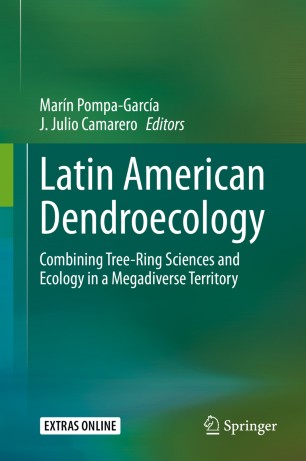Ver ítem
- xmlui.general.dspace_homeCentros Regionales y EEAsCentro Regional Patagonia SurEEA Santa CruzPartes de librosxmlui.ArtifactBrowser.ItemViewer.trail
- Inicio
- Centros Regionales y EEAs
- Centro Regional Patagonia Sur
- EEA Santa Cruz
- Partes de libros
- Ver ítem
Tree-Growth Variations of Nothofagus antarctica Related to Climate and Land Use Changes in Southern Patagonia, Argentina
Resumen
Isolated forest patches of Nothofagus antarctica (ñire) are frequent in the Patagonian forest-steppe ecotone. These remnants, also called relicts (R), are separate from the continuous forests (C). Over the past century, these ecotonal forests have been impacted by anthropogenic activities, including fires, logging, and cattle ranching. In order to identify in N. antarctica ring-width records the variations in tree growth associated with documented changes
[ver mas...]
Isolated forest patches of Nothofagus antarctica (ñire) are frequent in the Patagonian forest-steppe ecotone. These remnants, also called relicts (R), are separate from the continuous forests (C). Over the past century, these ecotonal forests have been impacted by anthropogenic activities, including fires, logging, and cattle ranching. In order to identify in N. antarctica ring-width records the variations in tree growth associated with documented changes in land use, five sites were selected in Santa Cruz, Argentina. In each site, increment cores from R and C were collected. We developed individual chronologies, and the relationships between regional climate variations and N. antarctica growth were established for each forest type and site. The similarities/differences between site-paired chronologies (R-C) were estimated by calculating moving correlation coefficients lagged by 1 year. N. antarctica regional growth was directly related to precipitation during the current growing season (November–December; r = 0.34, n = 62, p < 0.01), and inversely related to temperature (December–March; r = −0.58, n = 62, p < 0.001). Since the middle of the twentieth century, a progressive decrease has been recorded in regional radial growth, consistent with an increase in summer temperature and a decrease in spring precipitation. In the context of this regional response of N. antarctica to climate, differences in growth patterns between R and C were associated with past changes in land use. Overall, the largest differences between R and C chronologies were concurrent with the settlement of cattle ranches and the associated use of forests. Conversely, similarities between R and C records increased after the establishment of protected areas and during the implementation of similar management practices in both forest types. Our research provides the first dendrochronological records from Nothofagus antarctica for the Argentinean Patagonia and represents one of the first efforts to identify in tree-rings past changes in livestock practices in southern South America.
[Cerrar]

Autor
Vettese, Evangelina Soledad;
Villalba, Ricardo;
Orellana Ibáñez, Ivonne Alejandra;
Peri, Pablo Luis;
Editor - Compilador
Pompa-García, Marín;
Camarero, J. Julio;
Fuente
Latin American Dendroecology - Combining Tree-ring Sciences and Ecology in a Mega Diverse Territory (Ed. Pompa-García M.; Camarero J.J.). Springer Nature, Switzerland. Chapter 15, p. 331-354
Fecha
2020-03-15
Editorial
Springer Nature
ISBN
978-3-030-36929-3 (print)
978-3-030-36930-9 (online)
978-3-030-36930-9 (online)
Formato
pdf
Tipo de documento
parte de libro
Palabras Claves
Derechos de acceso
Restringido
 Excepto donde se diga explicitamente, este item se publica bajo la siguiente descripción: Creative Commons Attribution-NonCommercial-ShareAlike 2.5 Unported (CC BY-NC-SA 2.5)
Excepto donde se diga explicitamente, este item se publica bajo la siguiente descripción: Creative Commons Attribution-NonCommercial-ShareAlike 2.5 Unported (CC BY-NC-SA 2.5)

